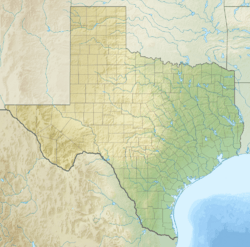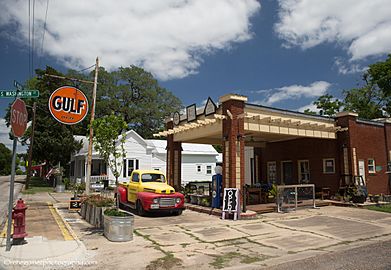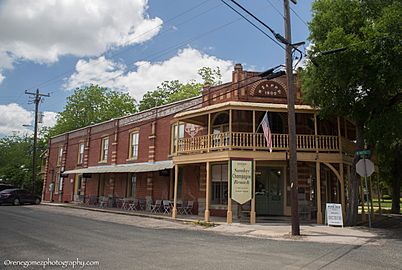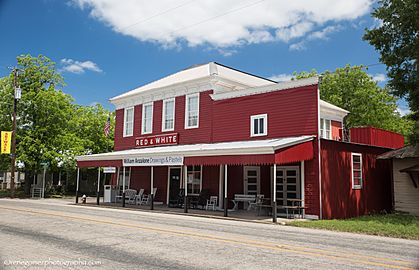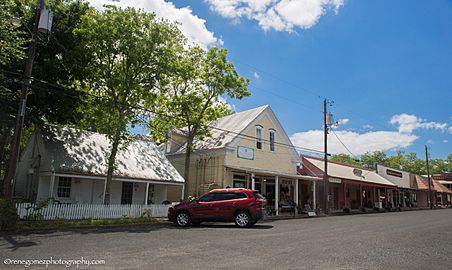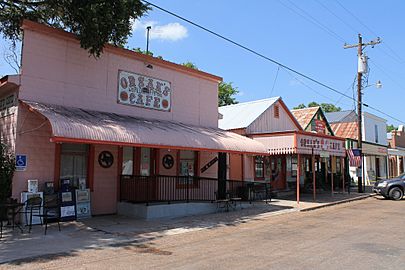Fayetteville Historic District (Fayetteville, Texas) facts for kids
Quick facts for kids |
|
|
Fayetteville Historical District
|
|
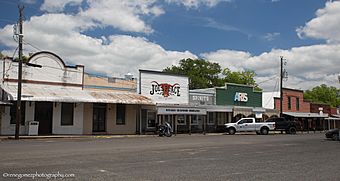
Town Square along N. Washington St.
|
|
| Location | Roughly bounded by E. Bell, N. Thompson (FM 1291), E. Fayette, E. Main (SH 159), Post Oak Lane, Fayetteville, Texas |
|---|---|
| Area | 153.5 acres (62.1 ha) |
| Built | 1853–1958 |
| Contributing architect | Carl H. Stautz |
| Architectural style | Italianate, Queen Anne, Romanesque |
| NRHP reference No. | 08000657 |
| Added to NRHP | 10 July 2008 |
The Fayetteville Historic District is a special area in Fayetteville, Texas. This small town is in the middle of rural Texas, between the big cities of Houston and Austin. The district is home to many old buildings, with the oldest one built way back in 1853. It covers about 153.5 acres and includes 345 buildings that are considered important to history. This historic district was added to the National Register of Historic Places on July 10, 2008. This means it's officially recognized as a place with a lot of history!
Contents
Discovering Fayetteville's History
Fayetteville is about 12 miles from LaGrange, which is the main town of the county. It's located in a part of Texas known for its gently rolling hills and good farming land. The town itself is quite compact, surrounded by farms.
The way the town is laid out, with its streets in a grid pattern, shows the influence of the Czech farmers. They became a big part of the area's community after the first German settlers in the mid-1800s.
How the Town Was Planned
Fayetteville was officially planned in 1850. The original plan had 28 blocks with a central town square. Even today, with a population of about 261 people, the town still looks much like that first plan. The town square is the very center of Fayetteville. It helps people find their way around and tells them where street numbers begin.
The streets in town are usually about 25 feet wide. They don't have raised curbs like many modern streets. Instead, they have drains with metal grates that lead to an underground storm sewer system.
The Old Courthouse in Town Square
Right in the middle of the town square is an old building that used to be a courthouse. It was built in 1880. The streets around the town square are extra wide, about 100 feet across, just as planned in 1850.
The town square is the main spot for businesses. The rest of the town is mostly homes. Many of the old shops are made of wood and have special false fronts. These fronts make the buildings look taller than they really are! Homes are usually simple, single-family houses on large lots.
The 1880 Courthouse Building
The old courthouse, called the Fayette County Precinct No. 2 Courthouse, is made of wood. It has a simple, two-story square shape. The front of the building has simple wooden stairs and double doors. Windows are placed evenly on all sides.
Building this Victorian-style courthouse cost about $600 in 1880, which came from local citizens. The county government added another $200. People even held a dance to raise money to paint the building! In 1887, a small jail, called a calaboose, was added with two cells. Later, in 1934, a clock tower was put on top of the roof. This was paid for by a ladies club! The building is no longer used as a courthouse today.
Shops and Buildings Around the Square
The town square has some unique buildings. Five of them have special pressed tin siding that looks like stone. There are also some brick buildings that replaced wooden ones lost in a fire in 1893.
Many of the commercial buildings are one or two stories tall. About 25 of the one-story buildings have those false front walls. These walls hide the roof and make the building look taller and more important. You'll see these false fronts all around the town square and in the business area. Many shops also have awnings that stretch over the sidewalk, sometimes with signs on top. The front of these shops usually has a main entrance with windows on either side.
Two-Story Commercial Buildings
There are seven two-story commercial buildings in the district. Two of them, located right on the town square, had a shop on the first floor and homes for the owners upstairs. These were the Sarrazin Store and Steve's Corner Store.
Most two-story buildings had a shop on the ground floor and offices, storage, or living spaces upstairs. Many of them also had canopies or roofs that extended over the sidewalk. A great example is the Zapp Building. This building is made of red brick with lighter brick details and a corner entrance. It was built in 1900 after an earlier building burned down. Today, it operates as an inn and is also listed on the National Register of Historic Places.
Photo gallery


